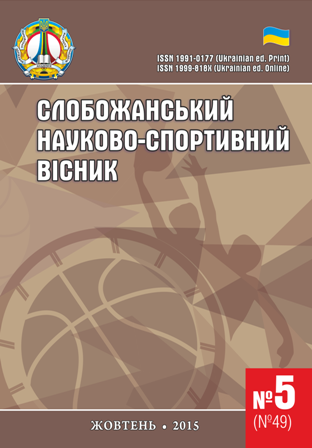Особливості відбору дітей для занять спортивною гімнастикою в сучасному Курдистані
DOI:
https://doi.org/10.15391/snsv.2015-5.001Ключові слова:
спортивна гімнастика, спортивний відбір, фізичні якості, здібностіАнотація
Мета: вивчити існуючі в республіці Курдистан організаційно-педагогічні умови відбору дітей для занять спортивною гімнастикою. Матеріал і методи: проводилося анкетування 24-х тренерів зі спортивної гімнастики та фахівців з фізичної культури республіки Курдистан. Вивчалися загальні питання відбору та методичні особливості відбору дітей для занять спортивною гімнастикою в Курдистані. Результати: анкетування виявило відсутність спільних апробованих тестів і наукових рекомендацій щодо їх використання, залежність якості відбору від досвіду тренера. Висновки: фахівці в галузі фізичної культури і спорту вважають неефективною існуючу систему відбору дітей для занять спортивною гімнастикою в Курдистані; тренери з гімнастики вважають за необхідне тестування у дітей рівня розвитку гнучкості, спритності, здібностей до прояву динамічної сили і збереження динамічної рівноваги.
Посилання
Antsyperov V. V. Sistema nachalnogo obucheniya yunykh gimnastov tekhnike dvigatelnykh deystviy : avtoref. dis…d-ra ped. nauk [The system of initial training of young gymnasts technique of motor actions : PhD thesis], Volgograd, 2008, 26 p. (rus)
Akhmed M. K., Abdel-shun M. Sh. Sistema fizicheskogo vospitaniya i zdorovya cheloveka [The system of physical education and health], Aleksandriya, 2007, 175 p. (arab.)
Botyayev V.L. Teoriya i praktika fizicheskoy kultury [Theory and Practice of Physical Culture], 2014, vol. 10, p. 94–97. (rus)
Gaverdovskiy Yu. K. Teoriya i metodika sportivnoy gimnastiki: Uchebnik v 2-kh tomakh. Tom 1 [Theory and Methods of Artistic Gymnastics: Textbook in 2 volumes. Volume 1],2014, 368 p. (rus)
Gaverdovskiy Yu. K. Teoriya i metodika sportivnoy gimnastiki . Uchebnik v 2-kh tomakh. Tom 2 [Theory and Methods of Artistic Gymnastics: Textbook in 2 volumes. Volume 2],2014, 232p. (rus)
Zhuravin M. L., Zagryadskaya O. V., Kazakevich N. V.,. Menshikov N. K. Gimnastika [Gym], Moscow, 2002, 448 p. (rus)
Kokhanovich K., Kokhanovi A. Teoriya i praktika fizicheskoy kultury [Theory and Practice of Physical Culture], 2014, vol. 5, p. 31–34. (rus)
Kokhanovich K. Teoretiko-metodichnі osnovi kompleksnogo kontrolyu v sistemі pіdgotovki yunikh gіmnastіv : avtoref. dis….k. nauk po fіzichnoі kulturi і sportu [Theoretical and methodological foundations of complex control in training young gymnasts : PhD thesis], Kiіv, 1999, 40 p. (ukr)
Paniotto V. I., Maksimenko V. S. Kolichestvennyye metody v sotsiologicheskikh issledovaniyakh [Qualitative methods in sociological research], Kiyev, 2003, 191 p. (rus)
Platonov V. N. Sistema podgotovki sportsmenov v olimpiyskom sporte (tom IV) [The system of training athletes in Olympic sports (Volume IV)], Kiyev, 2004, 606 p. (rus)
Yeretik A. A., Tereshchenko І. A., Dobrovolskiy Ye. Sportivna gіmnastika : navchalna programa dlya DYuSSh, DYuShOR, ShVSM [Gymnastics: training program for sports school], Kyiv, 2003, 81 p. (ukr)
Sutula V. A. Slobozans’kij nauk.-sport. visn. [Slobozhanskyi science and sport bulletin], Kharkіv, 2000, vol. 2, p. 120–122. (rus)
Khuseyn D. Ali Knbar. Razvitiye fizicheskikh kachestv, takticheskikh i psikhologicheskikh navykov sportsmenov [Development of physical qualities, tactical and psychological skills of athletes], Universitet Mustansiriya, 2013, 120 p. (rus)
##submission.downloads##
Опубліковано
Як цитувати
Номер
Розділ
Ліцензія
Авторське право (c) 2015 (Abdulvahid Dlshad Nihad) Абдулвахід Длшад Нихад

Ця робота ліцензується відповідно до Creative Commons Attribution 4.0 International License.
Наше видання використовує положення про авторські права CREATIVE COMMONS для журналів відкритого доступу.
Автори, які публікуються у цьому журналі, погоджуються з наступними умовами:
1. Автори залишають за собою право на авторство своєї роботи та передають журналу право першої публікації цієї роботи на умовах ліцензії Creative Commons Attribution License, котра дозволяє іншим особам вільно розповсюджувати опубліковану роботу з обов'язковим посиланням на авторів оригінальної роботи та першу публікацію роботи у цьому журналі.
2. Автори мають право укладати самостійні додаткові угоди щодо неексклюзивного розповсюдження роботи у тому вигляді, в якому вона була опублікована цим журналом (наприклад, розміщувати роботу в електронному сховищі установи або публікувати у складі монографії), за умови збереження посилання на першу публікацію роботи у цьому журналі.

 До уваги авторів!
До уваги авторів!


